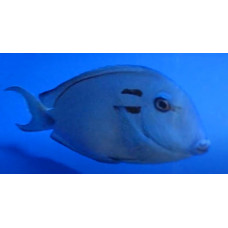Latin name
Acanthurus tennenti
Other names
Lieutenant tang
Identification
Have an elongated body with long obliques of elongated extreme rays of the caudal fin.
Features of fish fins
The dorsal and anal fins are long and extend to the caudal process. The caudal fin is crescent-shaped, with the tips becoming longer with age.
Fish colouring
The color of the fish is usually orange-beige, olive-brown, or steel-gray, but can turn dark brown with a tinge of red or purple when stressed. A dark line runs along the base of the dorsal fin, and a similar line runs along the base of the anal fin. There are two dark stripes behind the eye, and the scalpel-like scales protruding from the caudal area are blackish and surrounded by a large black spot with a bluish border. The caudal fin is bordered by a bluish-white band. Molodi have a black or yellow and black ring around the eye. As they grow older, they become more like adult fish, except for the black markings behind the eye, which are horseshoe-shaped at one stage of development.
Distribution
This species is widespread throughout the tropical and subtropical Indo-Pacific region. Its range extends from East Africa and Madagascar to southern India, Sri Lanka, Malaysia, Thailand and Indonesia.
Habitat
Found on rocks and coral reefs, on reef slopes and in channels between reefs, at depths of about 2 to 45 meters.
Size
The maximum length is 31 centimeters.
Behavior
Occurs singly, in pairs, or in small groups, more commonly in the bottom layer of water. Juveniles live alone or in groups in shallow waters near the shore in sheltered bays and coves. Often forms mixed groups with other fish species.
Food and feeding habits
Double-banded surgeonfish feed on algae that grow on the sea floor and detritus, as well as algal film that grows on sand and other substrates. This fish feeds outdoors during the day, often in small groups with parrotfish and other species.
Reproduction
Reproduction involves the release of sperm and eggs into the sea. The larvae are pelagic and return to the reef habitat after about seven weeks.
Fishing
Fish are sometimes caught for human consumption and for use in the aquarium trade.
Relationship with a person
It does well in captivity and is a popular aquarium fish.
| Classification | |
| Phylum | Chordata |
| Class | Actinopterygii |
| Squad | Acanthuriformes |
| Family | Acanthuridae |
| Genus | Acanthurus |
| Species | A. tennenti |
| Features | |
| Conservation status | Least Concern |
| Habitat | Pelagic |
| Life span, years | No information |
| Maximum body weight, kg | No information |
| Maximum length, cm | 31 |
| Sailing speed, m/s | No information |
| Threat to people | Edible |
| Way of eating | Bentophage |
Doubleband surgeonfish
Tags: doubleband surgeonfish


